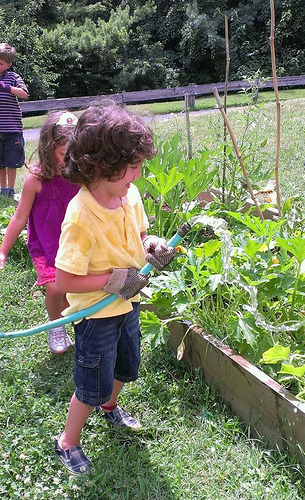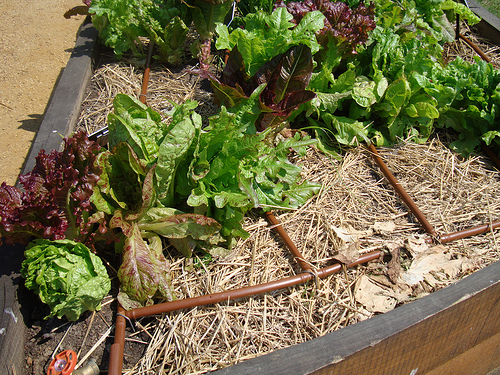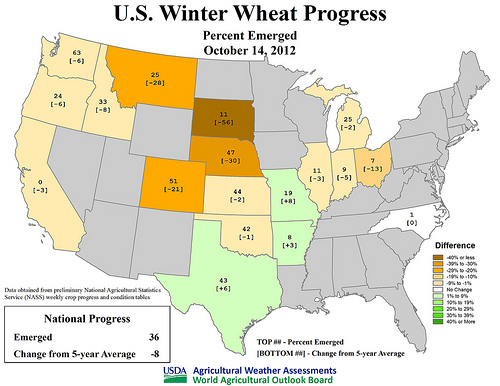In McLean, a community tucked inside Fairfax County, not everyone can access the food they need for good health. I interviewed Julie Mendoza about her efforts to connect hungry families in McLean with fresh produce.
Julie knew that Share McLean, a food pantry that serves hungry families in the area, often lacked fresh produce. As she was walking through the McLean community garden one day, she noticed that there was an abundance of fresh fruits and vegetables. She decided she would try to facilitate a relationship between the garden and Share McLean, calling it The Gardeners’ Share of McLean.

Young gardeners at St. Luke’s United Methodist Church grow food for The Gardener’s Share.
Read more »

Lodgepole pines, also called shore pines (Pinus contorta subsp. contorta) add punctuations of green to this muskeg near Sitka, AK. Pines growing in muskegs are stunted and very old. Tufted bulrush (Trichophorum caespitosum) plants are a dominant ground cover in this part of the muskeg and add color as their foliage turns orange and brown in the autumn. Flecks of red in the foreground are the scarlet foliage of bunchberry (Cornus suecica). Photo by Mary Stensvold.
Muskegs, a colloquial term for peat bogs, blanket 10 percent of the Tongass National Forest. These wetlands range in size from a few square feet to many acres. Over the ages, muskegs formed as Sphagnum mosses, rushes and sedges grew and built up spongy carpets in these very wet, almost treeless areas. Read more »
This week, USDA and other federal departments and agencies are recognizing the huge success of the 4th annual Feds Feed Families Food Drive. USDA employees, farmers, and friends raised a total of 2.77 million pounds of food this summer! The U.S. Forest Service was a big part of this effort and the stories below captures a snapshot of how several different Forest Service offices helped fill the shelves of food banks and food pantries in their communities.
In Duluth, Minnesota, the Superior National Forest Supervisor’s Office set a goal of 2,500 pounds for the food drive. As an incentive to encourage their team, Forest Supervisor Brenda Halter and Deputy Supervisor Tim Dabney promised they would wear Smokey Bear and Woodsy Owl costumes and greet people in Duluth’s Canal Park if they reached their goal. The staff pulled together and donated 4,500 pounds of food to Second Harvest Northern Lakes Food Bank. With the goal met and far exceeded, the Forest Supervisor and Deputy Supervisor put on the Smokey Bear and Woodsy Owl costumes! Read more »

Dutch Chef Eric Troost prepares an upscale dish using U.S. beef during a cooking demonstration for about 130 Belgian chefs Sept. 24. The demo was part of the first U.S. beef tasting event held in Belgium, which was hosted by the Foreign Agricultural Service (FAS) office in The Hague, Netherlands, and the U.S. Meat Export Federation (USMEF). The tasting was part of ongoing efforts to help expand U.S. beef exports to the European Union (EU). (Photo courtesy FAS The Hague)
The European Union (EU) is a relatively new market for U.S. beef exports. It wasn’t until August 2009 when the United States began exporting high-quality beef (marbled with a high fat content) to the EU under a negotiated tariff rate quota for non-hormone treated beef. Read more »
Tags: beef, Belgium, European Union, Exports, FAS, MAP, National Export Initiative, Netherlands, President Obama, The Hague, Trade
 Economic Growth, International, Trade
Economic Growth, International, Trade

The crops growing in the People's Garden at USDA Headquarters benefit from a drip irrigation system that Bob helped design. It is a planned irrigation system where water is applied directly to the root zone so each crop area is watered more uniformly and efficiently.
What do lawns, green roofs and electric bills have in common? If you ask Bob Snieckus, the answer is “energy.”
Even though Snieckus stays busy as National Landscape Architect for USDA’s Natural Resources Conservation Service (NRCS), he is also committed to conserving energy and improving sustainability in the Washington, D.C., buildings and landscapes where he works. Read more »

U.S. Winter Wheat Progress, October 14, 2012. (Click to enlarge image.)
Visit www.usda.gov/drought for the latest information regarding USDA’s Drought Disaster response and assistance.
According to the latest U.S. Drought Monitor, valid October 9, nearly two-thirds (63.55%) of the contiguous U.S. remains in drought. However, this is down nearly two percentage points from the late-September peak of 65.45%, as recent rains across the South and East have chipped away at the drought. At the same time, drought continues to gradually intensify across the northern Plains, where rangeland and pastures remain in dismal condition and winter wheat emergence has been hampered by a lack of soil moisture. Read more »





